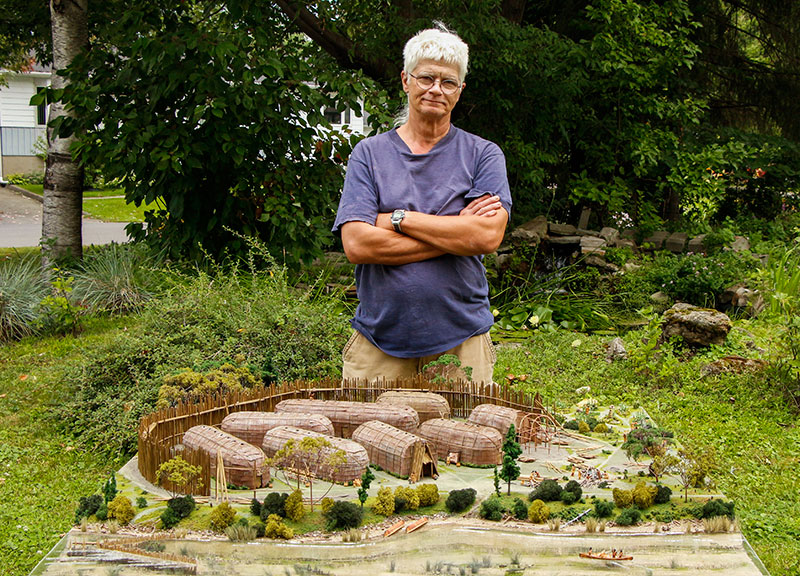ARCHEOFACT : A COMPANY THAT’S OUT OF THE ORDINARY
The wealth of individuals people is inextricably linked to the knowledge they have acquired. In the manner of a quest, everyone needs to feed the curiosity that drives him. Michel Cadieux is among those who have chosen to grow by extension of their expertise. Over the years, he created his own company, Archeofact.
Archaeology is a science that is evolving very quickly. It is essential to be aware of most discoveries if you want to be able to rebuild the facts as accurately as possible. Considering the challenge of learning an anthropological approach, the formation of Michel Cadieux is even more impressive. It stems from a strong energy and inexhaustible passion and ambition. Obviously, Michel Cadieux, despite no institutional learning, developed by interest a sharp sense of observation. Always driven by the desire to know the lifestyle of our ancestors, he has developed a skill to work with different authentic materials such as pottery, stone, bone, etc.. Recall that the feature was not for our ancestors, the only characteristic of an object. The playfulness was also clearly important.
Recognized by the Association of Quebec Archaeologists with nearly thirty site experiences and collaboration with several related areas, Mr. Cadieux is distinguished by its intellectual curiosity and how to disclose information resulting from scientific observations. The idea comes from that feeds his constant enthusiasm. Each project is a new idea that is growing and with it he walks and still learning. Researchers, First Nations, responsible for films, television series, museums, Mr. Cadieux contact for information or design, for example, ancient artifacts of a particular time. In short, all his observations and knowledge reflect his experience and professionalism in the field of archeology.

Reproduction of prehistoric cut stone tools – Michel Cadieux – Archéofact
Archeofact was established in 1992, a company that aims, among others, to help interpret the material through reconstituted material that wants more functional and plausible as authentic as possible. It is very important for him to transmit knowledge. By his observations and research, it also provides a database to document things or behaviors that are not.
Michel Cadieux has also developed and planned reconstruction of the Tsiionhiakwatha Interpretation center village, a semi-sedentary Iroquoian St. Lawrence village, with four longhouses fully furnished, smoking drying racks, gardens, and the whole is surrounded by a fence. The village shows the daily life of the Iroquois before the arrival of Europeans. This reconstruction was done with such attention to detail, this site was described by the National Geographic Society as the most authentic in the northeastern United States. Michel is responsible for housing structures, educational programs, training staff and finding new to present to the public.

Iroquoian vases of the St. Lawrence, Droulers site.
As for the site Droulers Michel continually evolving, always in search of new information gleaned from reserves museums, journals etc … With professionalism, he refuses to provide the opportunity to irrelevant material, making again, a form of education.
In conclusion, we consider three specific dimensions to Michel Cadieux.
- multidisciplinary collaboration
- creativity, originality any reproduction in any form whatsoever
- dexterity and mastery of complex skills.
His next challenge? Whatever you propose it to him …
MICHEL CADIEUX
Michel Cadieux benefits of an excellent publicity “by word of mouth”. In fact, he only lets out of his workshop, the pieces with which he is completely satisfied. With the reputation of quality, that it is already renowned for, the future looks promising for Archeofact
Any archaeological object can be reproduced.
For an evaluation, please contact me.
REPRODUCTIONS LIST
Flintknapping tool
- Knife
- Arrow point
- Javeline point
- Spear point
- Drill
- Scraper
- Pump drill
Polishing Stone
- Gouge
- Axe / Celt
- Propeller weight
- Mortar and pestle
- Steatite pot
- Steatite necklace Ulu
- Platform pipe
- Plummet
- Gorget
Ceramic
- Pots of all woodland’s periods
- Pot of 2 inches hight
- Pot of 4 inches hight
- Pot of 8 inches hight
- Pot of 10 inches hight
- Pot of more than 10 inches hight
- Pipes fo all periods
- Tubular pipe
- Pipe conical / obtuse angle / pipette
- Pipes of any form, trumpet, bowl, escutcheon
- Pipe coronet with or without decorations
- Pipe with human, human-animal
- Pipe bird, reptile or amphibian effigies
Necklaces
- Necklace with three row of ceramic beads, differents forms
- Necklace with one row of ceramic, bone, shell and steatite beads
- Iroquoian dice game
Bone and antler tools
- Spear
- Single or double barbed harpoon Fishhook
- Awl / needle
- Netmaking needle
- Inuit sewing case
- Thimble
- Comb without effigy
- Effigy comb
- Snow googles
- Snow knife
- Hoe, deer scapula Ulu
- Scraper, beamer
- Crooked knife, beaver tooth
- Cup and pin game, seven deer phalangeals
- Cup and pin game, one moose phalangeal
- Dice game, with bone counters
- Flute
- Whistle
- Buzz
- Foreshaft
- Shaft for harpoon, javeline or spear
Native copper
- Axe
- Knife
- Fishhook
- Arrow point
- Spear point
- Tubular beads necklace
- Arrow point, contact period Ulu
- Needles, awls or punch
Organic Material
- Black hash bow
- Drum
- Decorate drum
- Baby craddle board
- Burden frame
- Pump drill, to make fire
- Mortar and pestle
- Basquet fishing trap
- Fishing net with netsinkers and cedar floats
- La crosse stick
- La crosse ball
- Decoy
- Bread paddle







